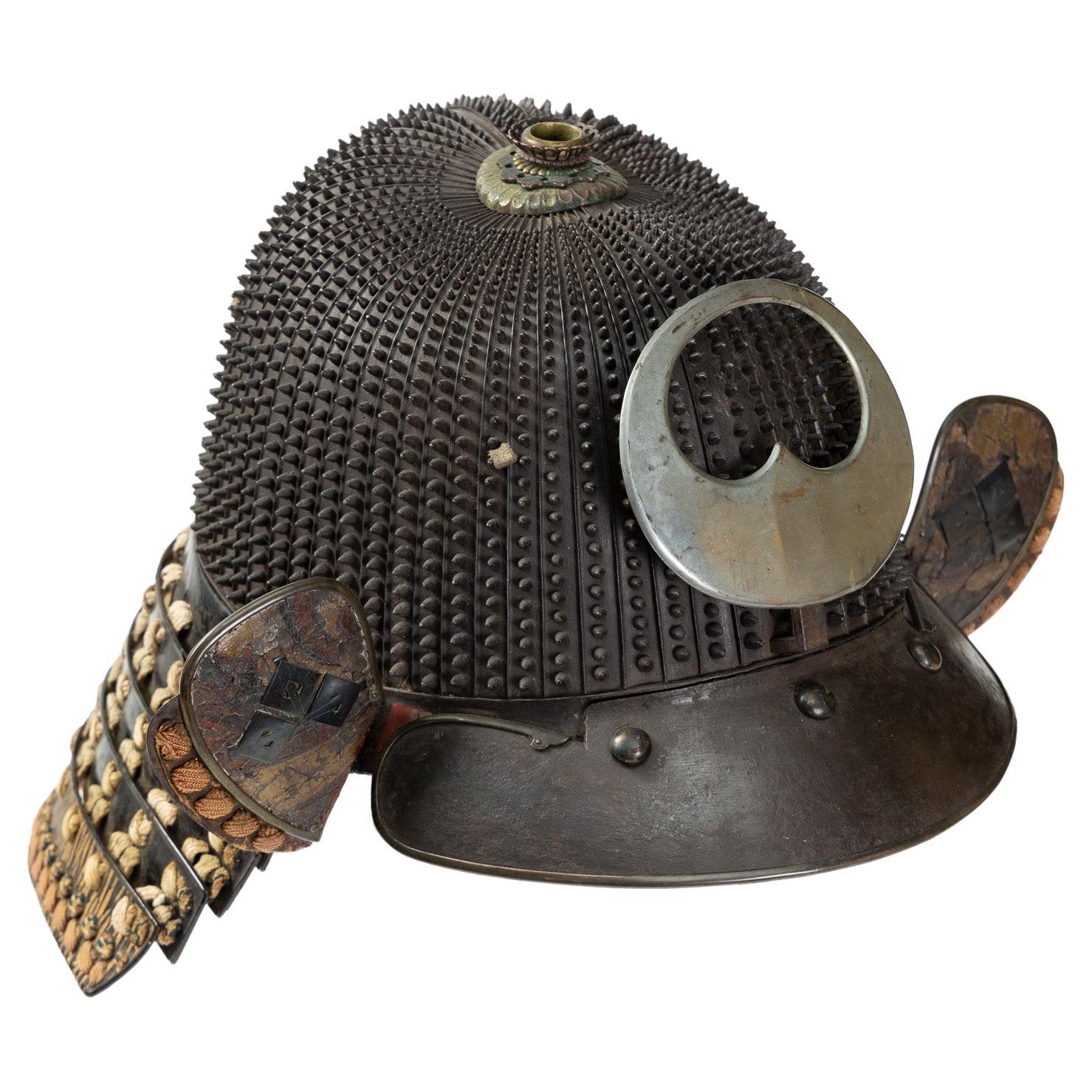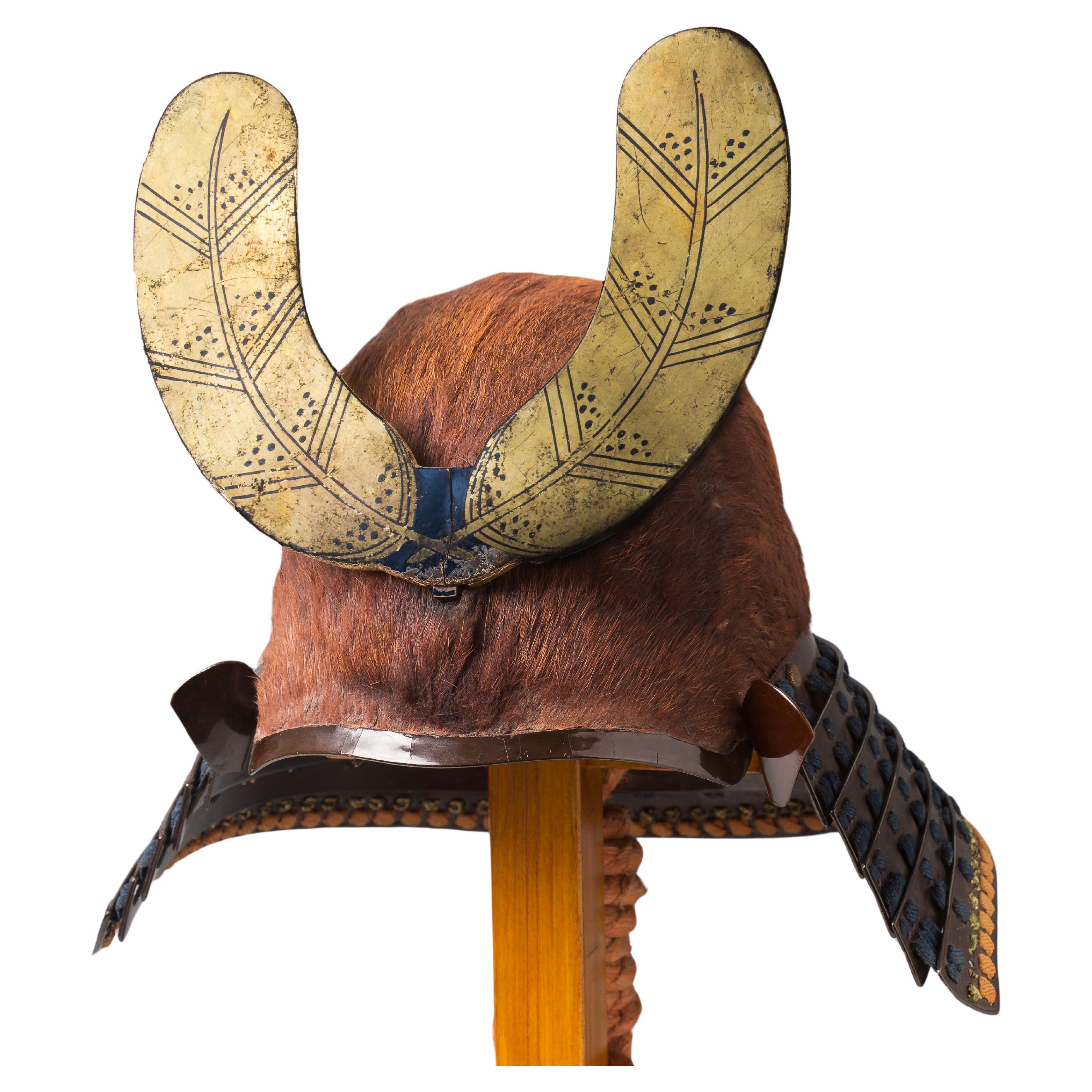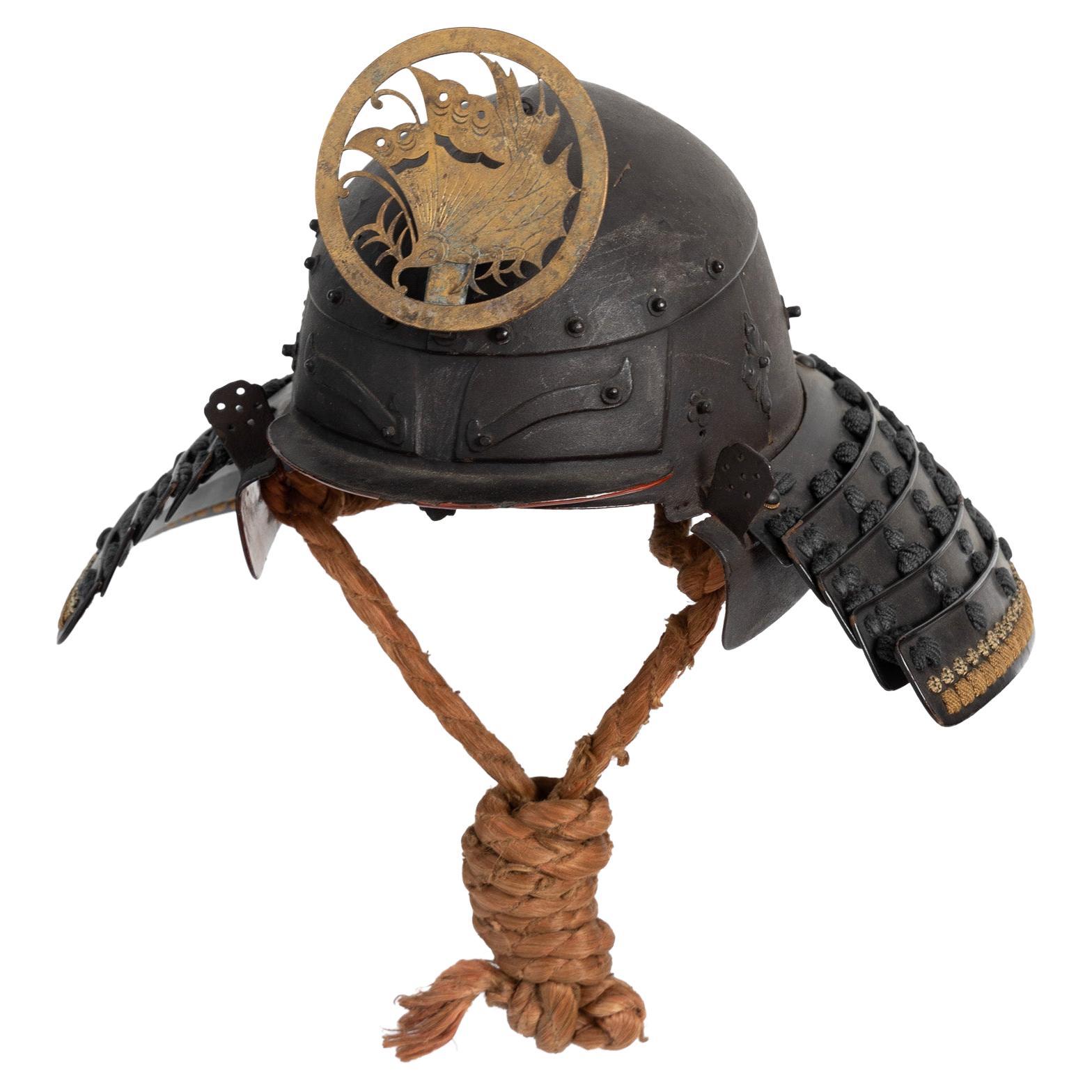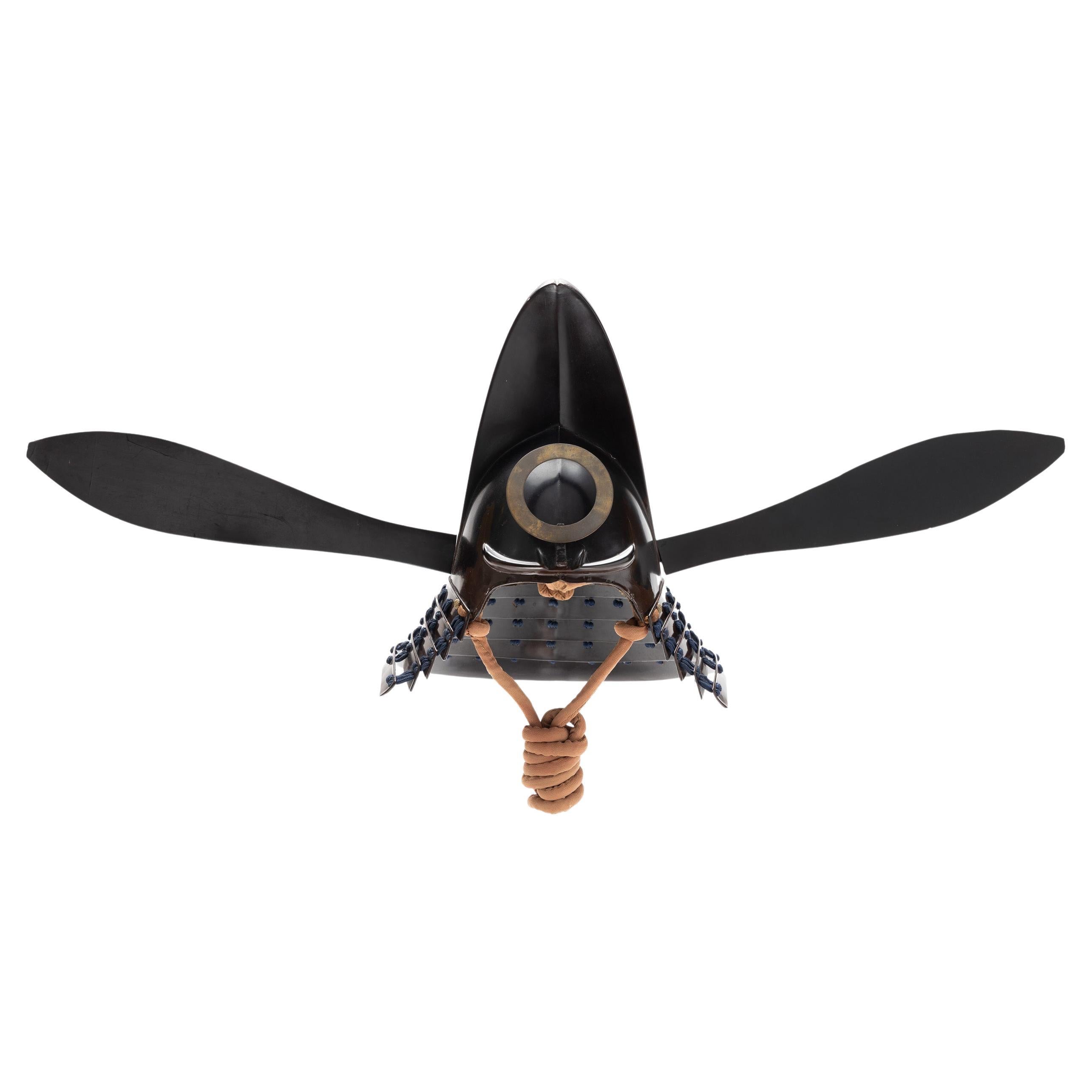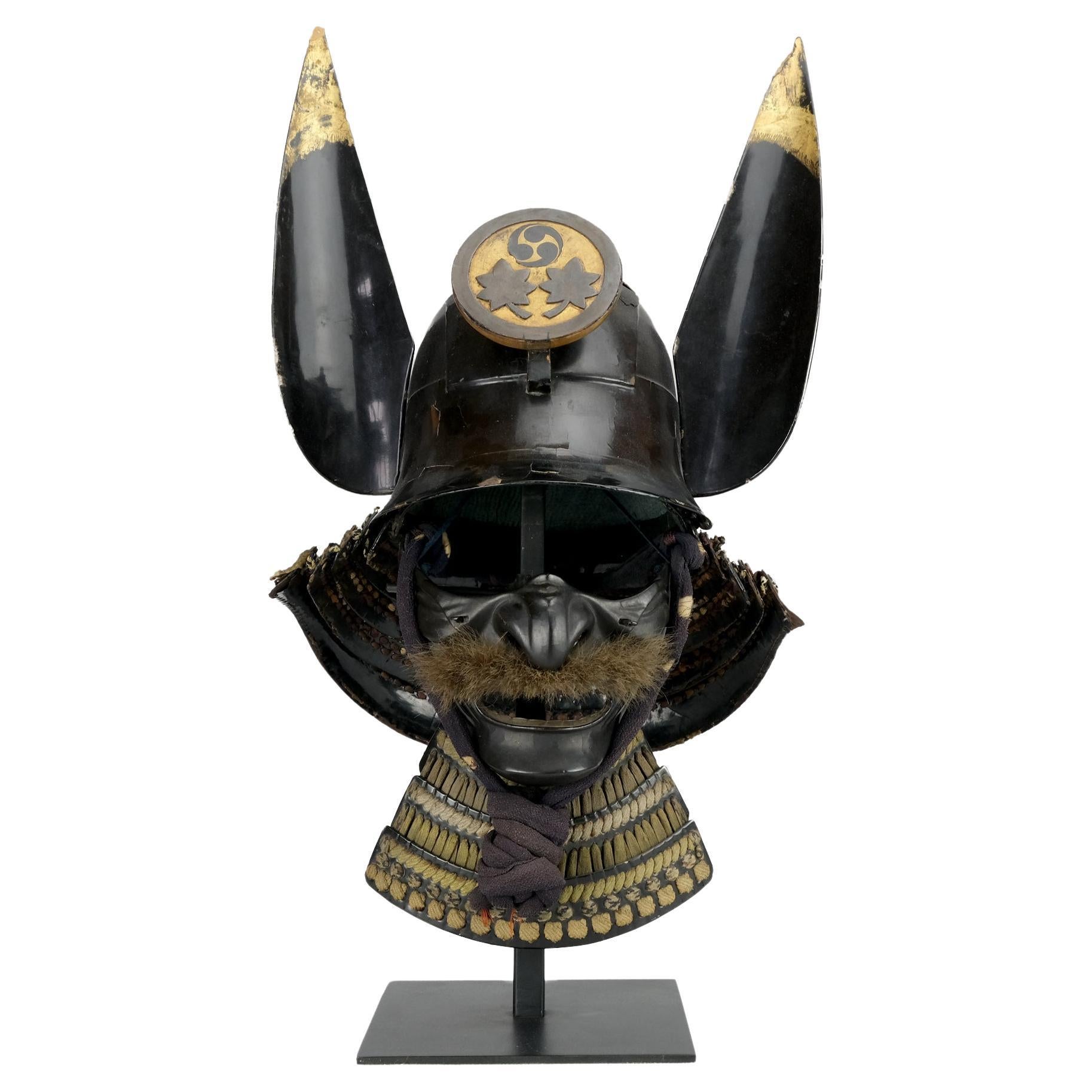Items Similar to Sujibachi kabuto 62-plate samurai helmet Haruta school, Edo period
Want more images or videos?
Request additional images or videos from the seller
1 of 13
Sujibachi kabuto 62-plate samurai helmet Haruta school, Edo period
About the Item
Sujibachi kabuto
62-plate samurai helmet
Haruta school, Edo period
17th-18th century
A lamellar helmet consisting of sixty-two plates joined with five rows of rivets. The surface is lacquered with black urushi, while the sujitate, the folded parts of each lamella, are lacquered in gold.
This color contrast is reminiscent of the akoda-nari type helmets produced by the Haruta school since the Kamakura period. The sinuous curves of all parts of the helmet are also typical of the production of this school, which remained active until the Edo period. Both the swelled tenkokuzan shape of the bowl, and the outlines of the fukigaeshi, the visor and the shikoro (neck guard) show in fact far more pronounced curvatures than those commonly found in this period and reminiscent of the work of Haruta Katsusada.
The five-plate shikoro, made of kiritsuke-kozane (simulated plates), bears two large fukigaeshi decorated in stencilled leather bearing a family crest (kamon) with three ivy leaves (tsuta). The rims, as well as those of the visor, are edged with engraved and gilded metal.
The maedate (front ornament) is made of gilt wood.
- Dimensions:Height: 19.69 in (50 cm)Width: 19.69 in (50 cm)Depth: 19.69 in (50 cm)
- Materials and Techniques:
- Place of Origin:
- Period:Mid-17th Century
- Date of Manufacture:circa 1680
- Condition:
- Seller Location:Milano, IT
- Reference Number:1stDibs: LU4250236055502
About the Seller
5.0
Recognized Seller
These prestigious sellers are industry leaders and represent the highest echelon for item quality and design.
Established in 2005
1stDibs seller since 2018
10 sales on 1stDibs
Typical response time: 1 hour
- ShippingRetrieving quote...Ships From: Milano, Italy
- Return PolicyA return for this item may be initiated within 7 days of delivery.
More From This SellerView All
- Koboshi Kabuto, Samurai Helmet with Standing Rivets Haruta SchoolLocated in Milano, ITKoboshi kabuto Samurai helmet with standing rivets Haruta School Early Edo Period, 17th century A 62-plate koboshi-bachi [helmet bowl with small s...Category
Antique 17th Century Japanese Arms, Armor and Weapons
MaterialsIron
- Sogonari Kabuto Samurai Helmet Shaped as a Human Head Early Edo PeriodLocated in Milano, ITSogonari Kabuto Samurai Helmet shaped as a Human Head Early Edo Period (1615 - 1867). Three-plates kawari kabuto covered with tawny hair to ...Category
Antique Early 1700s Metalwork
MaterialsFur
- Okitenugui Kabuto Samurai Helmet Shaped as a Head Towel Saika, Early Edo PeriodLocated in Milano, ITOkitenugui kabuto Samurai helmet shaped as a head towel Saika, early Edo period, 17th century The Haruta armorers who moved to Kii province in the early 17th century, took the name from the village where they worked, Saika, near Wakayama, possibly on request of the local daimyo, Asano Yukinaga, a great armour amateur. Specialised in the construction of plate helmets, they produced mainly two typologies of kabuto: one with six plates covered with a chrysanthemum-shaped plate on top and one shaped as a “head towel”, called okitenugui. The latter type of kabuto employs very heavy plates crafted in a curved manner and was improved in order to make it resistant to firearms. This okitenugui kabuto features some distinctive decorations of the Haruta school, including the application of cut-out iron elements, including eyebrows, washers and lozenge-shaped decorations on the sides. The ring on the top, however, is a rare feature and could be used to hold a small war flag.Category
Antique 17th Century Metalwork
MaterialsIron
- Tōkanmuri Kabuto Samurai Helmet in the Shape of a Court CAPLocated in Milano, ITTokanmuri kabuto Samurai helmet in the shape of a court cap Momoyama to early Edo Period 17th century The wearing of helmets that reproduced the shapes of traditional ...Category
Antique 17th Century Japanese Metalwork
MaterialsIron
- Toppai kabuto, Signed Haruta Yoshimasa and dated 1802Located in Milano, ITToppai kabuto, Samurai helmet from the Kajiwara clan. Edo period, dated 1802. Signatures: 筑藩士官 梶原 景泰 命春田 昌芳造之 享和二年壬 秋也 Chikushū (?) Shikan (officer) Kajiwara Kageyasu (?) Mikoto (lo...Category
Antique Early 19th Century Japanese Arms, Armor and Weapons
MaterialsIron
- Suji-bachi kabuto and menpo Signed by Myōchin Muneaki and dated 1853Located in Milano, ITSuji-bachi kabuto and menpo Signed by Myōchin Muneaki and dated 1853 Signature: Kaei 6 - Ushidoshi Oshu Nihonmatsu-ju Myōchin Ki (no) Muneaki saku Made in 1853 by Myōchin Ki Muneak...Category
Antique 18th Century and Earlier Metalwork
MaterialsIron
You May Also Like
- Japanese Samurai Helmet Kabuto Edo Period (1603-1867)Located in Hampstead, QCA Japanese Samurai black-lacquered helmet (kabuto) in suji bachi style and of a goshozan shape consisting of the: - main dome (hachi) made from 16 plates in natural iron riveted to...Category
Antique Early 19th Century Japanese Edo Metalwork
MaterialsIron
- Samurai Helmet "Zunari Kabuto" - Early Edo (circa 1610)Located in Paris, FRSamurai Helmet "Zunari kabuto" with 3 black lacquered iron plates. Japan, early EDO period, circa 1610. Neck protector (shikoro), 5-strip hineno, laced brown, beige and green. Centra...Category
Antique Early 17th Century Japanese Edo Antiquities
MaterialsIron
- Japan medallions tsuba Tanaka school Edo periodLocated in PARIS, FROvoid-shaped (nagamarugata) iron tsuba hammered and chased with medallions. On one side, medallions of a dragon with gold highlights and a komainu (or shishi – lion dog guarding the ...Category
Antique Mid-18th Century Japanese Metalwork
MaterialsGold, Iron
- Pair of 18th Century Japanese Edo Period Lacquered Samurai Iron StirupsLocated in Dallas, TX18th century Japanese Edo period Lacquered Samouri Iron stirups with original wooden lacquered insoles. Truly a beautiful pair of Japanese ...Category
Antique Late 18th Century Japanese Edo Metalwork
MaterialsIron
- Japanese Spear, Edo Period, SignedLocated in Stockholm, SEA Japanese long spear. Partly lacquered wood with a forged spearhead which is signed. High quality as most of Japanese items. Provenance: early 20th century Swedish collection.Category
Antique 19th Century Japanese Metalwork
MaterialsIron
- Antique Japanese Tomyodai, Edo periodLocated in Point Richmond, CAJapanese Tomyodai, a temple light stand created of iron and copper in the upright form of the Tama (Buddhist flaming jewel) with 13 ringlet projections to...Category
Antique Mid-19th Century Japanese Edo Metalwork
MaterialsCopper, Iron
Recently Viewed
View AllMore Ways To Browse
Stenciled Leather
Antique Copper Pots Turkish
Brass Incense Burner Hand Engraved
Japanese Copper Kettle
Islamic Mughal Gold
Mughal Wooden Tiger
Koro Antique
Meiji Period Bronze Bowl
Persian Metal Tray
Persian Metal Trays
Antique Singing Bowl
Antique Persian Brass Tray
Meiji Bronze Eagle
Antique Dallah Coffee Pot
Antique Dallah
Antique Copper Incense Burner
Burmese Bronze Bell
Early Cast Iron Kettle
